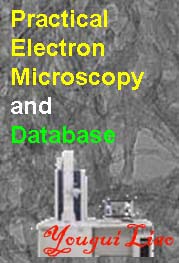
Chapter/Index: Introduction | A | B | C | D | E | F | G | H | I | J | K | L | M | N | O | P | Q | R | S | T | U | V | W | X | Y | Z | Appendix
| SEM (scanning electron microscopy)-based nanoprobing technique [1] is frequently used to identify the soft failure and non visible defects. Nanoprobing techniques, such as electron beam induced current (EBIC), can offer two-dimensional data; however, they are limited in effectively visualizing junction health in three dimensions. This technique provides the capability of operating probe tips in nanometer range to land exactly on top of the individual source, drain and gate tungsten contact, for instance, as shown in Figure 2825a. The SEM provides a high-resolution real-time image that facilitates locating the failing device and placing the probe tips. In this way, the locations of soft failure and non visible defects can become visible during electrical stressing.
One of the primary challenges in SEM imaging during nanoprobing arises from the need to protect sensitive samples by using low-energy electron beams (low eV), low beam currents, and minimal beam doses. These conditions are essential to prevent damage to the sample, but they significantly affect imaging quality. Specifically, they lead to high noise, low contrast, and image distortions, which complicate the accurate detection and positioning of nanoprobing tips. As a result, ensuring precise and reliable nanoprobing under these conditions requires advanced imaging techniques, careful optimization of SEM parameters and/or more advanced techniques. AI-driven models can be used to enhance the accuracy and efficiency of SEM imaging during nanoprobing by compensating for the challenges caused by the low-energy imaging conditions with the steps below [3]:
Figure 2825b shows four probe tips making contact with the source, drain, gate, and well of a single transistor. This configuration is part of a nanoprobing technique used for electrical characterization during failure analysis. The purpose of this setup is to collect a family of I/V (current-voltage) curves from both the good and failing transistors. Through comparison with a reference, the test revealed a 50 kOhm short between the source and drain of the suspect transistor. This result was consistent with other findings from Scanning Capacitance Microscopy (SCM) that indicated a source-to-drain short in the transistor.
[1] D. Faure, C.A. Waggoner, “A New Sub-micron Probing
Technique for Failure Analysis in Integrated Circuits”,
ESREF 2002.
|